A leave management system (LMS) automates the leave requesting, granting, and scheduling process—taking a lot of the busywork off the hands of your HR employee or manager. The best employee leave management system allows you to set time-off policies and holidays and automatically notifies managers of requests and employees of approvals or denials. It also includes a calendar that lets you see who is off and when.
We looked at many types of absence management software and narrowed our list down to the six best ones.
- Calamari: Best overall leave management system
- LeaveBoard: Best free system for businesses with <10 employees
- Leave Dates: Best for startups
- absence.io: Best for multinational companies
- Timetastic: Best for nonprofits and charities
- PlanMyLeave: Best for payroll integration and HR tools
Best Leave Management Systems Compared
Our Expert Score (out of 5) | Starting Monthly Price | Free Trial/Plan | Number of Countries Supported | Integrations | |
|---|---|---|---|---|---|
4.46 | 14-day free trial | 100-plus (multilanguage) | Slack, Google Apps, Microsoft 365, Basecamp, Asana, JIRA | ||
4.18 | Free plan available for <10 employees; 14-day free trial for paid plan | 50-plus (multilanguage) | Slack, Google Calendar, G-Suite, Office 365, Apple iCal | ||
4.15 | $1 per | Free plan for up to 5 users | 150-plus (English only) | Zapier, MS, Azure, Okta, Webhooks | |
4.05 | 14-day free trial | Unspecified (multilanguage) | Microsoft, Google, Slack, Teams, API | ||
4.03 | $1.50 per person | 30-day free trial | 250-plus (English only) | Google, Outlook, Teams, API | |
4.01 | 60-day free trial | 25-plus (multilanguage) | XERO, Quick Books, ADP, Zapier | ||
Not quite what you’re looking for? Check our buyer’s guides to the best time and attendance software or best HRIS software for more options.
Calamari: Best Overall Absence Management Software

Pros
- It has excellent features and customizations.
- It supports 100-plus countries and 5 languages.
- It can track remote workers.
Cons
- Reports are not customizable.
- Customizations can get time-consuming.
- It can’t integrate with payroll software.
Overview
Who should use it:
Calamari works in over 100 countries and is available in English, German, Polish, French, and Spanish. You can use it for teams in multiple countries and remote workers as well. It’s especially good for remote teams and multinational companies, as it works with many languages and holiday schedules; however, Timetastic may be a better fit because it’s preloaded with holidays from 250-plus countries, whereas Calamari requires you to input them manually or from Google.
Why we like it:
Calamari has competitive pricing (although Leave Dates is the cheapest for 10-plus employees) and the most features, like its communication tools between employees and managers and its document attachment features. It earned a 4.46 out of 5 on our evaluation, with perfect scores in functionality and popularity, and has a terrific set of features for tracking leaves, great customer service, and an intuitive interface. Users like it too (scoring 4.5 on G2 and 4.7 on Capterra), stating how easy it is to track time off and the functionality of reporting. Plus, the email reminders help managers stay on target with requests.
Standard Plan 15% discount applied when paid annually
Includes support with onboarding, data import assistance, customer service via chat and email, online documentation and help center, all currently available integrations, SSO with Google, Slack, JIRA, and Office, standard API quote, and standard document set.
- Time Off: $2.50 per employee, per month; $25 minimum required; includes unlimited absence types, multicountry policies, multisteps approval flows, reports, integrations, notifications, and more
- Time and Attendance: $3 per employee, per month; $30 minimum required; includes 7 time tracking methods, manual timesheets entries, approval flows for editing, reports, integrations, notifications, and more
- Core HR: $2.50 per employee, per month; $25 minimum required; includes people directory, electronic HR documents, access restriction, document management flows, full history of actions, notifications, and more
Premium Plan 15% discount applied when paid annually
Includes all Standard Plan options, plus customized contract and data processing agreement, dedicated customer success specialist, dedicated integrations Additional charge , regular review of account configuration, migration of data from other services, adjusted payment methods, SAML logging, customized API quote, tech consultations, and additional training sessions
- Time Off: $5 per employee, per month; $50 minimum required
- Time and Attendance: $6 per employee, per month; $60 minimum required
- Core HR: $5 per employee, per month; $50 minimum required
NOTE: Time off, Time and Attendance, and Core HR features are the same between both the Standard and Premium plans.
- Document attachment: Calamari’s document attachment capabilities are handy for special-case leave requests like those allowed by the Family Medical Leave Act or for internal use. PlanMyLeave and Timetastic also allow this—the others only have room for notes.
- Manager/employee communication: Other leave management software on our list allow your employees to make comments. A few integrate with Slack or Microsoft Teams for communication. Calamari, however, has built-in communications features so that managers can discuss leave requests with the employee or other supervisors. It also works via Slack.
- Widespread workforce: Calamari’s leave management program lets you track remote workers and communicate with them in-app. It also has holiday tools for over 100 countries and comes in five languages: English, French, German, Spanish, and Polish. Timetastic, LeaveBoard, and PlanMyLeave are also good choices for international teams, while absence.io offers the greatest choice for languages.
- Mobile app with shortcuts: Calamari has apps on Android and iPhone, on Android (4.2 out of 5 stars) and iOS (4.5 out of 5 stars). It stands out because it lets you put a shortcut to key features right on the screen of your smartphone, so you don’t need to open the app.
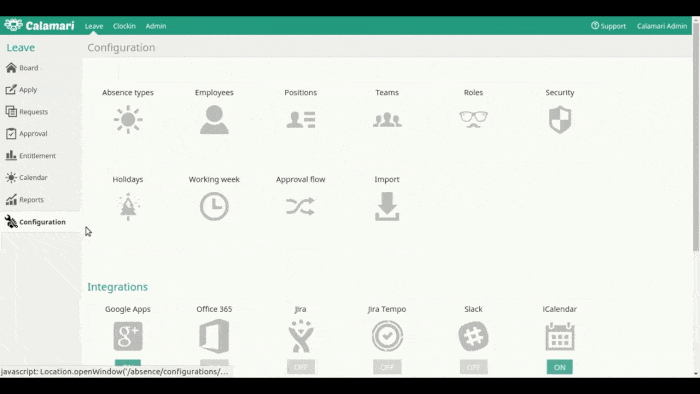
You can create multiple absence types and rules with Calamari. (Source: Calamari)
LeaveBoard: Best for Free Software for <10 Employees

Pros
- It offers a Free plan for very small businesses.
- It has a report builder.
- It can work in 50-plus countries and 4 languages.
- It offers assistance with setting up an account and importing data.
Cons
- It has very few integrations (mostly calendar apps).
- It has no phone and chat support.
- There’s a 10-employee minimum for paid plans.
Overview
Who should use it:
LeaveBoard is the only absence management software on our list that provides an indefinite free plan for up to nine employees, making it perfect for very small businesses. Pricing is still very low for businesses with 10 or more employees. It works in English, French, German, and Romanian and offers holiday calendar support for over 50 countries.
Why we like it:
LeaveBoard has excellent automation features and makes it easy for managers to see and approve leaves. It’s also got the strongest reporting tools of those on our list. LeaveBoard earned 4.18 out of 5 on our evaluation. The customizable reports earned it a perfect score for reporting; it also got an excellent score for functionality, along with Calamari and PlanMyLeave. The lack of a mobile app isn’t a huge issue as it is designed to be accessed on mobile through the web, so you don’t really need one. However, support is through a contact form, and the integrations are sparse, which hurt its score. Like all the leave management systems on our list, it does have an API.
- Free: Leave management tool, maximum 9 employees, HR dashboard, time off tracking, employee directory, Slack integration, HR reports, absence calendar, leave policies, and time off management
- Pro: $1.35 per employee, per month $13.50 per employee per year, if paid annually ; includes everything in Free plan, plus unlimited users, priority support, and advanced leave policies
- Enterprise: Contact for demo and quote For companies with more than 81 employees ; includes everything in Pro plan, plus account manager and priority support
- Intuitive interface: While we found all the programs easy to use (and users agreed with us), LeaveBoard especially impressed us with its bright, easy-to-use interface. The card-style dashboard keeps your most important information right where you need it. The calendar also uses lighter dots to show leaves submitted but not approved—a nice function for planning.
- Free version: LeaveBoard’s free version works for nine employees or fewer. It offers nearly all the tools except advanced leave policy creation and priority support. It’s a great option for small businesses that don’t expect to increase their employee base soon. Leave Dates’ free plan is limited to five users but includes all its tools.
- Reports: We found LeaveBoard had the best options for reports because you can build your own custom reports and manipulate the leave reports it already supplies. For further analysis, such as chart creation, you need to export to Excel.
- Additional leave options: You can set the system to do extra functions, such as automatically approving leaves or having employees automatically ask for a replacement, which is a great help for service industries like restaurants. There are options to retroactively request leaves and set up leave intervals, so expiring leaves are used first. Calamari offers the option to automate approvals but not the replacement feature.
- Overlap warning: LeaveBoard not only supplies employees with a calendar that shows who has already applied for days off but can also send a warning if an employee asks for a day off and a colleague has already taken that day. This can save managers from dealing with staffing issues. Calamari lets you manually check, while others provide a list or a calendar to show who is off and when.
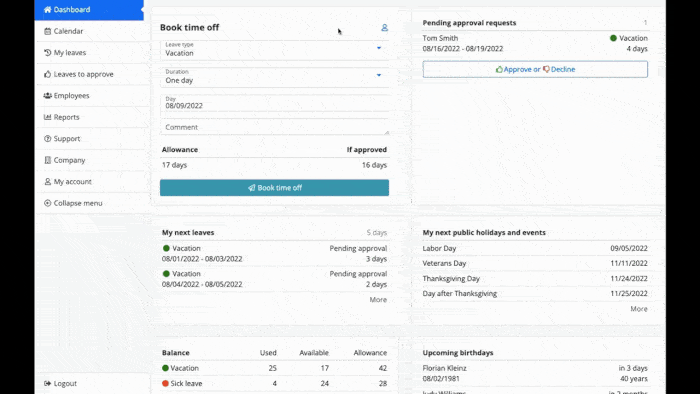
LeaveBoard’s schedule uses colors and icons to show types of leave, projected leave, and even half-days. (Source: LeaveBoard)
Leave Dates: Best Leave Management System for Startups

Pros
- It has a Free plan.
- It is preloaded with public holidays for 150-plus countries.
- It is highly rated for mobile and desktop.
- It has a simple, straightforward design that’s easy to learn.
Cons
- It’s in English only.
- Its Free plan is limited to 5 users.
- It provides support via email only.
Overview
Who should use it:
Leave Dates is best for small offices or startups because it offers a free plan with all the features for companies with five or fewer employees. After that, it’s a simple $1 per person, per month—the cheapest on our list.
Why we like it:
Leave Dates is very easy to use and covers all the most important tools you need, such as an employee calendar, leave customizations, customizable approval processes, and even the ability to assign comp time. This employee leave management system earned a solid 4.15 out of 5 on our rubric, with a perfect score for pricing and high scores for its tools, functionality, and popularity. Users gave it high marks across the board, but especially for ease of use and customer support. It lost points for not having customizable reports and for not having phone or chat support. It has pricing Pricing unique for each country. See website for details. for the US, UK, Australia, and Canada, but does not offer other languages than English.
- Zapier integration: While most of the leave management systems on our list provide APIs, Leave Dates also uses Zapier, which makes it easy to integrate into thousands of HR, accounting, and other software. As a startup, you can use Zapier to add integrations as you acquire more tools.
- Custom leave types: Even with the free plan, you can create any type of leave you need, including comp time (TOIL). You can also create custom leave approval processes with multiple approvers and others who simply need to be notified. You can set up carry-over policies, accruals, and more. While others on our list have most of these features, they’re sometimes on higher plans. LeaveBoard, for example, does have advanced leave policies in the free plan.
- Highly-rated mobile app: LeaveDates has apps for both Android and iOS. While the Android app remains unrated (with 10,000-plus downloads), the iOS app earned an impressive 4.8 out of 5 with 140 ratings. The app does what most do: let you track and request leave, see your company or department calendar, and get notifications about leave approval or requests.
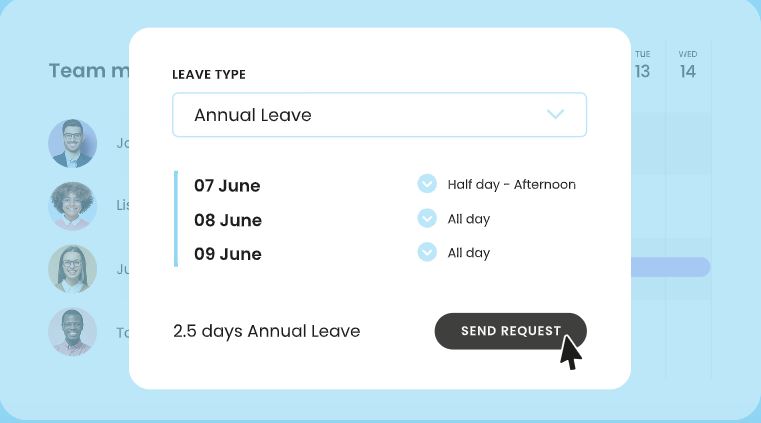
Leave Dates users can request leave right from the calendar, which makes it easy to ensure they don’t conflict with others’ time off. (Source: Leave Dates)
absence.io: Best for Multinational Companies

Pros
- It is available in 7 languages.
- It can integrate with Microsoft Azure.
- It has built-in substitution management.
- It offers phone support 24/7.
Cons
- It has no custom reports.
- It can’t integrate with payroll software.
- It can’t attach documents to requests.
Overview
Who should use it:
absence.io stands out because it offers seven languages, worldwide support, and includes substitute management right on the request, making it a great choice for service industries, restaurants, or any business where you can’t leave a spot unmanned.
Why we like it:
absence.io excels in its basic tracking and absence management functions, allowing employees and managers to approve on any device and manage calendars. This employee leave management system earned 4.05 out of 5 on our rubric, and real-world users on third-party independent review sites rated it above average (4.0 on G2 and 4.6 on Capterra). Its multiple languages, 24/7 phone support, and highly rated mobile app earned it strong scores for leave tools, functionality, and ease of use. It lost points on popularity, and the lack of customizable reports hurt its score, as did the fact that you cannot attach documents to leave requests.
- Basic Function:
- Add-on Functions:
- Time tracking: €2 per person, per month (about $2.17)
- Digital Personnel Files: €2 per person, per month (about $2.17)
- Expense Management: €5 per person, per month (about $5.42)
absence.io offers exclusive discounts for large companies with more than 100 employees.
- Choose your sub: Like Calamari, employees can select substitutes when scheduling leave. This is a great tool for restaurants, service industries, or anytime you need a point of contact who can answer questions while someone else is away.
- Worldwide reach: absence.io natively works in English, French, German, Spanish, Portuguese, Polish, and Turkish and has server hosting in Germany, making it an excellent choice for the European market. However, it has customers all around the world, from Canada to South Africa and Australia to South America. For comparison, Calamari offers five languages.
- 24/7 phone support: This is the only leave management system on our list that offered customer support by phone (aside from some Enterprise plans). Further, it has 24/7 worldwide support.
- Highly regarded on desktop and mobile: absence.io earned high user review ratings on Apple phone app (4.9 out of 5 stars). On the Android app, however, it only earned 3.5 out of 5 stars—still a good score, but not the best.
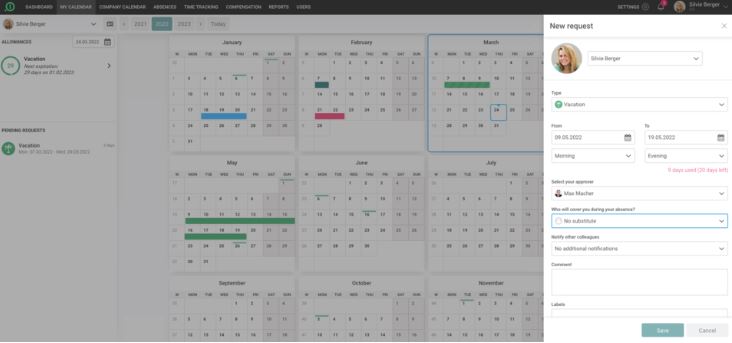
Absence.io lets you set up and approve leave from the calendar. (Source: absence.io)
Timetastic: Best for Nonprofits & Charities

Pros
- It is preloaded with holidays from 250-plus countries.
- It is highly rated by users.
- It offers Time Off in Lieu tracking on the calendar.
Cons
- It has email support only.
- It can’t attach documents to requests.
- It is in English only.
Overview
Who should use it:
Timetastic generously offers a 50% discount to charities and other nonprofits, making it our top choice for those kinds of businesses. It can work in multiple countries and includes preloaded holidays for over 250 countries. Over 175,000 people use it—many businesses switched to Timetastic from spreadsheets or old-fashioned wall calendars.
Why we like it:
Like the other LMS software on our list, the automations and PTO customization policies are top-notch. Timetastic earned 4.03 out of 5 on our evaluation. It earned perfect marks for features and high scores for functionality. It took hits for not having a report builder and for support being available only by contact form and during working hours in England. While it has a multinational reach, its only operating language is English.
- Basic: $1.50 per user, per month; includes unlimited users and departments, shared calendar, holiday allowance record, holiday approvals, mobile and desktop app
- Pro: $2.50 per user, per month; includes all features of Basic plan, plus limit bookings on individual leave types, absence trends and insights, burnout alerts, enhanced user profiles, integrations with multiple platforms, single sign-on
50% discount for Certified B Corporations, Fair Tax Mark holders, 1% for the Planet members, and NHS Trusts
- Customizable approvals: Most of the software on our list automatically alerts all the managers or makes a request to an administrator if the manager is not around. Timetastic, however, allows you to create a customized workflow for approvals.
- Time Off in Lieu (TOIL): Timetastic lets you calculate and give time off as compensation for overtime rather than overtime pay. While all but Calamari do this, we especially liked how this feature was included in the calendars, which is a great tool for hourly workers who use this feature.
- Preloaded holidays: Most of the programs on our list have holidays for the locations they work in. Timetastic, however, boasts the most, with over 250 countries and 3,000 regions. You set the country and staff member, and the software selects the holidays for you.
- Burnout Board (with Timetastic Pro): Timetastic has a unique tool called the burnout board that shows you who has not been taking time off. Not only does this help flag people who are in danger of losing leave days at the end of the year, but it can also help you spot overworked employees.
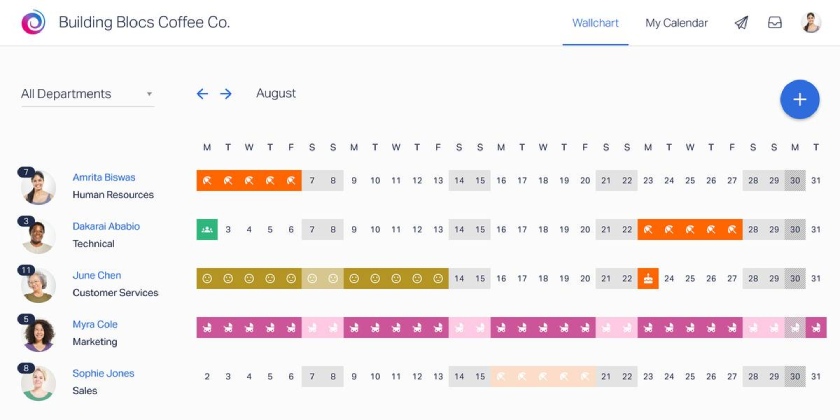
Timetastic’s schedule lets you deep dive into leaves right from the calendar. (Source: Timetastic)
PlanMyLeave: Best Leave Management System for Integrations and HR

Pros
- It offers additional free modules for document management, onboarding employees, and more.
- Its advanced plan includes time and attendance and HR tools.
- It can customize language on request.
- It can integrate with payroll software.
Cons
- Monthly subscriptions below $100 are billed semiannually or annually.
- It is mobile friendly, but only a third-party Google app.
- Minimum fee is $30 per month.
Overview
Who should use it:
PlanMyLeave is an inexpensive leave management system that stands out because it provides basic tools for employee management, like onboarding, employment histories, document management, employee appreciation, and more. This saves you money by taking care of some of your HR needs. It’s also the only one on our list that has ready-made integrations for payroll and accounting programs, making it ideal for companies that need these integrations.
Why we like it:
PlanMyLeave has a larger list of tools than others on our list, allowing users to not only track time and attendance, but also manage performance and track reimbursements. It earned a 4.01 out of 5 on our rubric. It did very well in price, features, and functionality, although the lack of custom reports brought its score down some. It’s not as popularly rated and does not have a dedicated mobile app. However, it offers more flexibility for requests and approvals than the other leave management software on our list.
- Leave Management: $1 per user, per month $30 minimum monthly
- 16 Tools: $2 per user, per month $50 minimum monthly ; includes PTO tracker, eNPS surveys, engagement surveys, expense reimbursements, performance management, OKR, employee data and analytics, kudos and awards, 1-1 meetings, timesheet, document repository, shift management, 360 degree feedback, project management, onboarding and offboarding, and travel management
- Unlimited Users: $50 per month flat rate per listing below
- OKR plus 1-on-1 meetings
- Performance review, 360 degree feedback, and goal setting
- eNPS, engagement, and pulse surveys
- Awards, kudos, and anytime feedback
Custom rates and discounts for high employee volume, educational institutions, and nonprofits.
- Encashed comp time: PlanMyLeave, like Timetastic and LeaveBoard, can calculate time off in lieu (TOIL) of time; however, it offers additional tools like calculating encashed time (such as time-and-a-half for working holidays). The others on our list do not do this.
- HR tools: The Leave and Timesheets Management Plan includes modules for tracking skills and employment history, managing documents, onboarding and offboarding workflows, travel requests, employee appreciation, and more. None of the other LMSes on our list offer extras like these. If you are a small business that doesn’t need full HRIS software, PlanMyLeave could provide you with what you need.
- Free language customization: PlanMyLeave claims it can be set to any language. The FAQs list English, French, German, Chinese, and Turkish. It also says it can add any language you need at no extra charge. While Calamari offers several languages, it does not offer this level of flexibility. (absence.io lists seven languages.)
- Integrations: PlanMyLeave integrates with Xero, QuickBooks, ADP, and other payroll software. It lets you store documents on Google Drive and Dropbox, works with multiple third-party calendars, and integrates with Slack and HipCat. It now offers Zapier for more integration capability.

PlanMyLeave has tools to ensure compliance, such as requesting documents to qualify for sick leave. (Source: PlanMyLeave)
How to Choose the Best Leave Management Systems
Managing your employees’ leave is important for keeping accurate records, both for payroll purposes and for an overall snapshot of the employee’s attendance. There are many factors that can help you decide on the best leave management system software. Some of the most common are affordability, features and tools offered, and how well the system integrates with calendar and HR software.
The best leave management systems should have the following tools:
- A calendar showing all requested and approved leave, usually defined by type (sick, PTO)
- Customizable leave types
- Automated leave balance, including carry-over days and accruals
- Employee portal for seeing who is off and requesting leave
- Ability for managers to quickly view and approve leave requests
- Notifications by email, in-app, or elsewhere (like Slack) when leave is requested, approved, or denied
- List of national or local holidays that are established days off
Below are some additional things to consider when choosing:
- Affordability: Small businesses are tasked with keeping costs low and profits high to maintain their return on investment. Leave management software should help keep those costs low by being affordable. There are a few on our list that are completely free, however, your employee roster must be under ten employees. Other than the free plans offered, prices range from $70-$200 annually to start and increase depending on the number of employees in your company.
- Integrations: Integration capabilities with other time and attendance software and HR or payroll software are something to consider when choosing a leave management software for small business. Most on our list integrate with traditional calendars, such as Google, Apple iCal, Outlook, and more. Others integrate with communication software as well, such as Slack, Teams, etc. Those that integrate directly with your human resources and/or payroll software, like PlanMyLeave, make it easy to record paid time off on pay stubs.
- Calendar Availability: While all leave management systems work with a calendar to report time off, not all offer holiday recordkeeping in multiple countries and multiple languages. Those that do give you a leg up have automatic time off tracking, making the process less time consuming and more accurate.
- Time Off in Lieu Feature: Software that offers and helps you track time off taken in lieu of compensation can help you stay compliant. Most of the software on our list does offer this feature built-in. Of note, to be legal, the time off granted instead of overtime compensation should be paid time off.
- Warnings: Good absence management systems have built in warnings that will notify supervisors when certain conditions occur. For example, there are overlap warnings that will let you know when an employee or other employees in the same department have requested the same days off.
Methodology: How We Evaluated the Best Leave Management Systems
For this lineup, we weeded out any leave management systems that only came as part of a time and attendance software package or HR software. Those that were left all offered an excellent set of basic features; the distinctions came in the extra details. In this update, we considered some different products and checked for new features and improvements.
Click through the tabs below for our full evaluation criteria:
20% of Overall Score
We looked at affordability and transparency, and gave credit for free plans. A low minimum price was also rewarded with points.
20% of Overall Score
These tools make managers’ jobs easier: importing holidays, setting rules, having accruals automatically calculated, calculating comp time, and getting automated messages when leave is requested and approved.
20% of Overall Score
This criterion looked at calendar integrations and customizations. Additionally, we evaluated if the software was offered in multiple languages and communication features outside of email.
10% of Overall Score
Here, we looked at feedback from real-world users, especially on customer service; however, many of the apps did not have a lot of reviews.
10% of Overall Score
We looked for standard and customizable reports. While all the products had some kind of leave reporting, only LeaveBoard offered much in terms of customization.
20% of Overall Score
We considered interface, customer support, online guides, and dedicated help for integration. Those that integrated with other time and attendance or payroll software scored favorably.
Frequently Asked Questions (FAQs)
A leave management system is software that handles the requesting, scheduling, and approval of employee time off. Most leave management systems are cloud-based and are mobile-friendly or have an app.
When an employee wants to request leave, they go to the app or their employee portal and fill out the request, and the software notifies the manager. The manager views the request, checks the calendar, and approves or rejects as desired. The employee gets notified, and, if approved, the system updates the calendar automatically. It also deducts the time off from employee balances.
Leave management software makes it easy to request, approve, and track absences for any reason, taking a lot of time and headaches off managers and HR. By having accurate records and tracking, you can stay compliant with labor laws on vacation and even overtime. They also ensure you are paying your employees properly.
The average leave management system costs between $1 and $2.50 per user, per month. Some offer free plans for a very small number of people, while others offer discounts for higher volume or specific industries like education or nonprofits.
Bottom Line
There are other ways to track employee hours and time off. However, if you are ready to put aside the spreadsheets and wall calendars but don’t want a full HRIS or time-tracking system, absence management software can provide the automations you need to make leave planning a breeze instead of a chore. They are reasonably priced, and most work in multiple countries.
Calamari tops our list because of its excellent feature set and high ratings by real-world users. While among the most expensive, it does offer multiple languages and holidays, as well as customizations to keep your leave policies in compliance with local law. It comes with a free trial of all its features. Try Calamari today.

